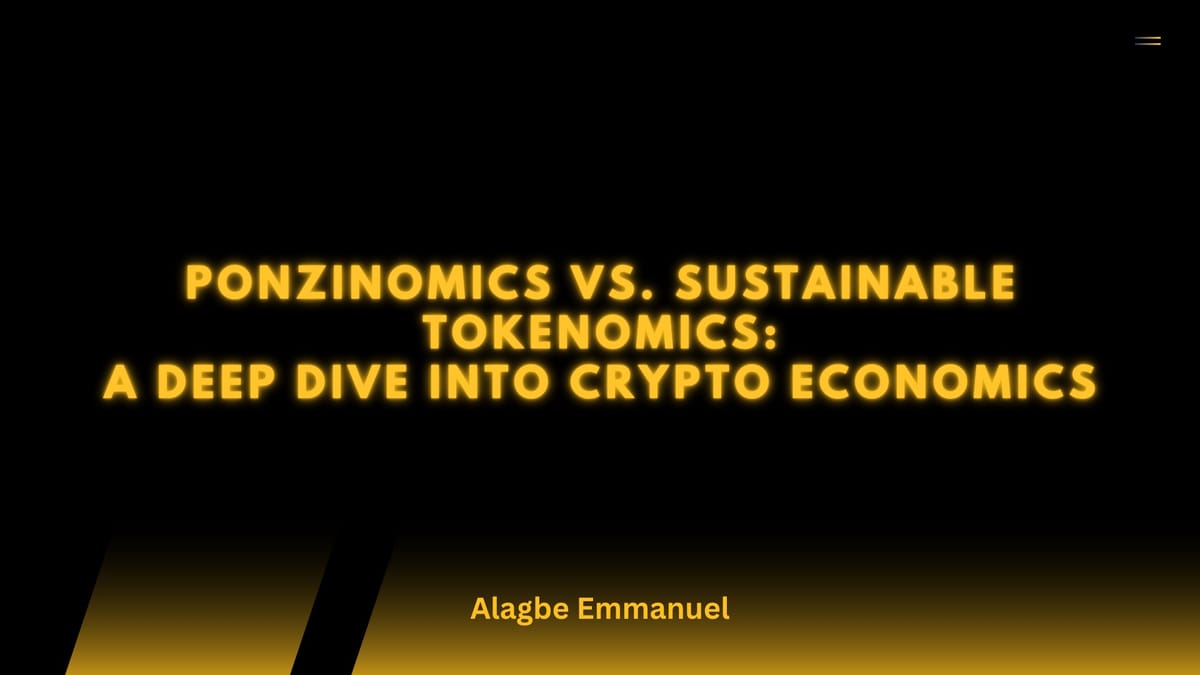Ponzinomics vs. Sustainable Tokenomics: A Deep Dive into Crypto Economics

The cryptocurrency space is a fascinating blend of innovation, speculation, and economic experimentation. At the heart of every blockchain project lies its tokenomics, the economic model governing how tokens are created, distributed, and managed. However, not all tokenomics are created equal. Some projects fall into the trap of Ponzinomics, a term used to describe unsustainable, pyramid-like schemes disguised as legitimate token economies. In contrast, sustainable tokenomics aim to create long-term value, incentivize healthy participation, and avoid collapse. This article explores the differences between Ponzinomics and sustainable tokenomics, their characteristics, and how to identify them.
What is Ponzinomics?
Ponzinomics refers to token economic models that rely on unsustainable mechanisms, often resembling Ponzi or pyramid schemes. These models prioritize short-term hype and speculative price increases over long-term viability. While they may appear lucrative initially, they typically collapse when new participants dwindle or early investors cash out.
Key Characteristics of Ponzinomics
- Overreliance on New Investors:
- Ponzinomics-driven projects depend heavily on a constant influx of new investors to sustain token value. Early investors are often rewarded with outsized returns, paid for by later participants.
Example: Projects promising "guaranteed" high yields (e.g., 100% APY) without a clear revenue source often fall into this category.
- Unsustainable Reward Structures:
- Tokens are distributed through aggressive staking or yield farming rewards that outpace the project’s actual revenue or utility. This leads to hyperinflation or eventual depletion of token reserves.
Example: A project might offer 10% daily staking rewards, but the underlying protocol generates negligible fees to support such payouts.
- Lack of Real Utility:
- The token lacks meaningful use cases within the ecosystem. Its value is driven purely by speculation or promises of future utility that never materialize.
Example: Tokens marketed as “the future of finance” but with no working product or clear application.
- Opaque or Manipulative Token Distribution:
- Large portions of the token supply are often held by insiders, early investors, or the project team, who can dump tokens on retail investors at inflated prices.
Example: A project might allocate 50% of tokens to the team with no vesting schedule, allowing them to sell immediately.
- Hype-Driven Marketing:
- Ponzinomics projects lean heavily on aggressive marketing, influencer endorsements, and promises of “moon” prices to attract naive investors.
Example: Social media campaigns with exaggerated claims like “10x in a month” without a solid economic foundation.
The Downfall of Ponzinomics
Ponzinomics projects often follow a predictable lifecycle:
- Hype Phase: Aggressive marketing and high yields attract early adopters.
- Pump Phase: Token prices soar as new investors pour in.
- Dump Phase: Early investors and insiders sell off, causing a price crash.
- Collapse Phase: The project fails to deliver, funds dry up, and the token becomes worthless.
High-profile examples like Bitconnect and certain DeFi “yield farming” scams illustrate the dangers of Ponzinomics. These projects lured investors with promises of exponential returns, only to collapse when the influx of new money slowed.
What is Sustainable Tokenomics?
Sustainable tokenomics, on the other hand, are designed to create long-term value for all stakeholders, users, developers, and investors. These models align incentives, promote ecosystem growth, and ensure economic stability. Sustainable tokenomics are grounded in real utility, transparency, and mechanisms that prevent hyperinflation or collapse.
Key Characteristics of Sustainable Tokenomics
Clear Utility and Demand:
- The token has a well-defined role within the ecosystem, such as paying for services, governance, or incentivizing specific behaviors.
Example: Ethereum’s ETH is used to pay gas fees, creating consistent demand as the network grows.
- Balanced Token Supply and Distribution:
- Token issuance is carefully managed to avoid hyperinflation. Supply mechanisms like capped issuance, burning, or deflationary models help maintain value.
Example: Binance Coin (BNB) uses periodic token burns to reduce supply, increasing scarcity over time.
- Revenue-Generating Mechanisms:
- The protocol generates real revenue (e.g., transaction fees, service fees) to support token rewards and ecosystem development.
Example: Uniswap generates fees from trading, which can be redistributed to liquidity providers or used for governance.
- Fair and Transparent Distribution:
- Tokens are distributed equitably, with clear vesting schedules for team and insider allocations to prevent dumps.
Example: Polkadot (DOT) implemented a transparent token distribution with lock-up periods for early investors.
- Incentive Alignment:
- Rewards are structured to encourage long-term participation, such as staking for network security or governance participation.
Example: Cardano (ADA) incentivizes staking to secure the network, with rewards tied to protocol activity.
- Governance and Adaptability:
- Sustainable projects often include decentralized governance mechanisms, allowing token holders to propose and vote on changes to the protocol.
Example: Compound (COMP) allows token holders to govern protocol upgrades, ensuring adaptability.
Why Sustainable Tokenomics Matter
Sustainable tokenomics create a virtuous cycle:
- Ecosystem Growth: Real utility drives adoption, increasing token demand.
- Stability: Balanced supply and demand prevent extreme volatility.
- Long-Term Value: Transparent governance and revenue generation build trust and resilience.
Projects like Bitcoin (BTC) and Chainlink (LINK) exemplify sustainable tokenomics. Bitcoin’s fixed supply and mining rewards create scarcity, while Chainlink’s token is integral to its decentralized oracle network, driving demand as the ecosystem grows.
Ponzinomics vs. Sustainable Tokenomics: A Side-by-Side Comparison
| Aspect | Ponzinomics | Sustainable Tokenomics |
|---|---|---|
| Token Utility | Minimal or speculative | Clear, integral to ecosystem |
| Reward Structure | Unsustainable, high-yield promises | Balanced, tied to revenue or utility |
| Token Supply | Hyperinflationary or poorly managed | Controlled, often deflationary |
| Distribution | Insider-heavy, opaque | Transparent, fair, with vesting |
| Revenue Source | Relies on new investors | Generates real revenue (fees, services) |
| Longevity | Short-term, collapses without new money | Long-term, resilient to market changes |
| Marketing | Hype-driven, exaggerated claims | Focused on utility and adoption |
How to Spot Ponzinomics and Avoid Scams
Given the prevalence of Ponzinomics in the crypto space, investors and users must exercise due diligence. Here are practical tips to identify red flags and protect yourself:
- Research the Token’s Utility:
- Ask: What does the token do? Is it essential to the protocol, or just a speculative asset?
- Check if the project has a working product or a clear roadmap.
- Analyze Token Distribution:
- Review the token allocation. Are large portions held by the team or insiders without lock-ups?
- Look for transparency in how tokens are distributed (e.g., whitepaper, on-chain data).
- Evaluate Reward Promises:
Ascertain whether yields are sustainable by cross-referencing with protocol revenue or utility. - Check for Revenue Generation:
- Does the project generate real revenue (e.g., fees, subscriptions)? If not, how are rewards funded?
- Be wary of projects promising high APYs without a clear revenue model.
- Beware of Hype:
- Avoid projects relying on influencer shilling or “to the moon” rhetoric.
- Legitimate projects focus on utility and adoption, not speculative price predictions.
- Use On-Chain Analytics:
- Tools like Etherscan, Dune Analytics, or Nansen can reveal token movements, insider dumps, or suspicious activity.
- Trust Your Instincts:
- If it sounds too good to be true (e.g., “1000% returns in a month”), it probably is.
The Path Forward: Building a Sustainable Crypto Future
The crypto industry is still in its infancy, and the prevalence of Ponzinomics reflects growing pains. However, as the market matures, sustainable tokenomics are becoming the standard for projects aiming to survive and thrive. Regulators, investors, and developers are increasingly prioritizing transparency, utility, and long-term value creation.
For Investors:
- Prioritize projects with strong fundamentals, clear utility, and transparent governance.
- Diversify investments to mitigate risk.
- Stay informed through reputable sources and community discussions (e.g., X posts, whitepapers, developer updates).
For Developers:
- Design tokenomics with sustainability in mind, focus on utility, revenue, and balanced incentives.
- Engage with the community through transparent communication and governance.
- Avoid shortcuts like excessive token issuance or insider-heavy distributions.
For the Industry:
- Advocate for clearer regulatory frameworks to weed out scams and protect users.
- Promote education to empower investors to make informed decisions.
- Foster innovation in token models that align incentives and drive real-world adoption.
Conclusion
The battle between Ponzinomics and sustainable tokenomics is a defining challenge for the cryptocurrency industry. While Ponzinomics may offer short-term gains, its unsustainable nature inevitably leads to collapse, eroding trust and harming the ecosystem. Sustainable tokenomics, by contrast, build resilient, valuable, and long-lasting projects that benefit all stakeholders.
As the crypto space evolves, the ability to distinguish between these models will be crucial for investors, developers, and users alike. By prioritizing utility, transparency, and balanced incentives, the industry can move toward a future where blockchain technology delivers on its promise of decentralization, innovation, and economic empowerment.


Comments ()